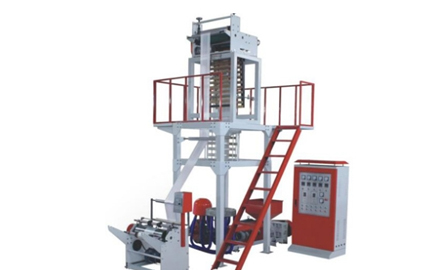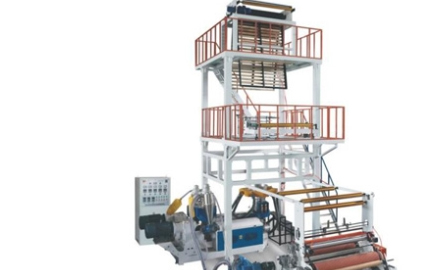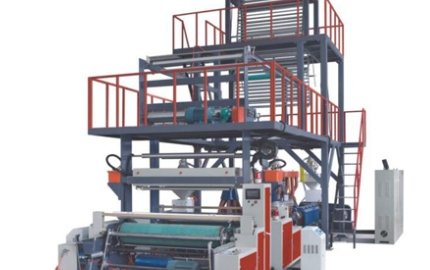In the field of plastic processing, blown film extrusion technology has become a core process for producing high-quality films due to its unique forming principles and wide-ranging applicability. This process resembles a precise industrial "bubble-blowing" performance, transforming polymer resins into thin, durable films that provide critical materials for diverse sectors such as food packaging, medical protection, and agriculture. This article delves into the working principles, key components, and practical applications of blown film extrusion machines, offering insight into the charm of this technology.
Inspired by the everyday act of blowing bubbles, the blown film process replaces soapy water with polymer resins (such as polyethylene or polypropylene) and achieves large-scale production through industrial equipment. The core workflow is as follows:
1. Raw Material Plasticization: Plastic polymer pellets are fed into the extruder, where they enter a heated barrel. A rotating screw inside the barrel generates shear and frictional forces, gradually melting the raw material into a uniform melt. Additives such as antistatic agents, adhesives, and UV stabilizers can be incorporated during this stage to endow the film with specific properties.
2. Bubble Formation: The molten polymer exits the extruder and enters an annular blown film die head. Compressed air introduced through the die head inflates the melt into a tubular bubble, which expands vertically like a large transparent balloon. The thickness and width of the bubble can be precisely controlled by adjusting parameters such as air pressure, extrusion speed, and haul-off speed.
3. Cooling and Solidification: As the inflated bubble rises, it first passes through a bubble cage. This structure provides physical support to maintain bubble stability during expansion and can be paired with an optional internal bubble cooling (IBC) system to accelerate cooling. The IBC system circulates cooling gas inside the bubble, rapidly solidifying the molten polymer from a liquid to a solid state and forming a film tube with mechanical strength and dimensional stability.
4. Film Formation: At the top of the machine, the cooled bubble is guided by a tube collapsing frame into nip rollers, which compress it into a double-layer film. The film is then wound into rolls by a winder, completing the production process.
1. Extruder
The extruder is the core power source of a blown film machine, directly influencing the plasticization quality and production efficiency. Modern machines often use single-screw or twin-screw extruders; for multi-layer composite films, multiple extruders can work in tandem to co-extrude different polymer melts, enabling the design of layered film structures.
2. Blown Film Die Head and Air Ring
The design of the die head determines the initial shape and uniformity of the bubble. The precision of the annular die gap must be controlled at the micrometer level to ensure even extrusion of the melt. The air ring provides a stable stream of cooling air, with the uniformity of wind speed and direction critical for cooling efficiency and film thickness consistency. Innovative designs like high-speed twin die blown film machines, which use one extruder to drive two die heads, enhance productivity while reducing floor space, reflecting the intelligence of industrial design.
3. Bubble Cage and IBC System
The bubble cage’s framework acts as a "guardian" for the bubble, providing mechanical support in the early stages of expansion to prevent deformation caused by air fluctuations or weight. The optional IBC system shortens cooling time by over 30% through internal cooling, reducing internal stress from uneven cooling and improving the film’s optical and mechanical properties.
4. Nip Rollers and Winder
Nip rollers compress the bubble into a stable film and control the haul-off speed to match the extrusion rate, preventing over-stretching or sagging. The winder requires a precise tension control system to ensure uniform roll tightness for subsequent processes like slitting and printing. Fully automatic winders, such as those equipped in CHYI YANG’s LDPE/LLDPE blown film machines, enable one-touch roll changing, reducing labor intensity and enhancing production continuity.
RK-SJA50/800 Single Layer Blown Film Machine is 38 chrome molybdenum aluminum alloy by high-quality nitriding treatment, the screw is also made of cemented carbide coating, high hardness, wear and corrosion resistance. With an impressive production speed of up to 80m/min, it is capable of churning out high-quality supermarket bags and vest bags that not only exhibit a visually appealing finish but also possess remarkable tensile strength, ensuring their durability and reliability in various applications.

RK-ABA 3 Layer Film Blowing Machine is characterized by high efficiency, stability, excellent wear resistance and cooling effect, and is the preferred equipment in the field of packaging material production.With a speed up to 100m/min, it co-extrudes three plastic melts precisely for versatile three-layer films. The water cooling device boosts film durability. Handling materials like HDPE, LDPE, LLDPE, it has adjustable film width (e.g., 600 - 1000mm for RK-ABA1100) and thickness (0.015 - 0.08mm).

RK-3JS50/55/65 ABC Film Extrusion Machine is an equipment for the efficient production of three-layer plastic films. It can produce high-quality, multi-functional films and is widely used in many industries. Molten plastic is blown into tubular film using air blowing technology. Cooling system to cure the plastic film and adjust the size of the film by means of a stretching device. High speed production of large quantities of film up to 45m/min.

Films produced by blown film extrusion technology are widely used across industries due to their customizable properties:
Food and Daily Chemical Packaging: Plastic bags, cling films, and composite packaging films require high transparency, excellent barrier properties (moisture and oxygen resistance), and heat-sealing capabilities to preserve food freshness. For example, films for frozen foods must withstand low temperatures, while microwave-safe films require heat resistance.
Medical and Hygiene Fields: Medical infusion bags, sterile packaging films, and substrates for disposable hygiene products demand strict standards for cleanliness, chemical stability, and sterilization compatibility. Multi-layer co-extrusion technology enables the production of composite films with antibacterial or puncture-resistant functions for specialized medical needs.
Agriculture and Horticulture: Greenhouse films, mulch films, and silage films require UV resistance, heat retention, and dust resistance. For instance, long-life drip-proof films with antifogging agents reduce condensation in greenhouses, improving light transmission and crop growth.
Industrial and Construction Sectors: Industrial packaging films, building waterproofing membranes, and geomembranes prioritize strength, weather resistance, and chemical corrosion resistance. Geomembranes for water conservancy projects, often millimeter-thick, achieve high impermeability through multi-layer designs.
Choosing the right blown film extrusion machine requires considering several key factors:
Product Requirements: Determine the machine configuration based on the target film’s material (e.g., LDPE, LLDPE, HDPE, PP), thickness (microns to millimeters), and number of layers (single or multi-layer co-extrusion). High-barrier food packaging films, for example, often require three or five-layer co-extrusion machines.
Production Capacity: Select equipment based on annual output plans, considering extrusion volume and line speed. High-speed machines capable of hundreds of meters per minute suit large-scale production, while lab-scale equipment is ideal for R&D and small-batch trials.
Energy Efficiency and Intelligence: Prioritize machines with energy-saving motors, efficient heating/cooling systems, and intelligent controls. Manufacturers like RUIKANG optimize screw designs and temperature control algorithms to reduce energy consumption by 15–20% while supporting remote monitoring and automatic process adjustments for stable production.
After-Sales Service and Industry Experience: Partner with experienced manufacturers for full-cycle support from equipment selection to process training, minimizing operational risks. Their products are renowned for ease of use, stability, and cost-effectiveness, serving film producers in over 30 countries.
Blown film extrusion machines are a cornerstone of modern plastics industry, thanks to their ingenious mechanical designs and flexible processes. From household cling film to industrial geomembranes, every roll of film embodies the perfect fusion of precision machinery and polymer science. Collaborating with experienced manufacturers like RUIKANG ensures not only reliable equipment but also insights into technological trends, helping businesses gain a competitive edge. As technology evolves, blown film extrusion will continue to deliver more efficient, sustainable, and intelligent film solutions for global industries.